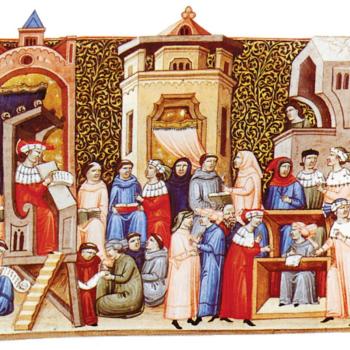Each semester, I teach an introductory course on what my department not very accurately terms “Religions of the West”: Judaism, Christianity, and Islam. Especially as a historian of Christianity in the United States, the subject matter is a bit of a challenge for me.
In a recent post, my co-blogger Philip Jenkins quite correctly observed that many Religious Studies textbooks “reflect a strong prejudice towards the textual.” They “commonly place too much emphasis on texts and scriptures, rather than the actual lived experience of the religions in question.”
Substitute “professor” for “textbook” and guilty as charged! Of course, what Philip terms the “Curse of Scripture” is less of a curse when the subject matter is Judaism as opposed to Hinduism. In my course, students spend about half of the semester gaining a basic familiarity with the Tanakh, Christian Bible, and the Qu’ran. My goals here are somewhat modest. At the very least, I try — without overwhelming success — to convince students that all of the texts in the Tanakh are also scripture for Christians.

More seriously, I begin with this approach not because I think it is necessarily the best way to introduce students to these traditions as a whole but because the texts are fascinating and are something that students can read and profitably discuss. Over the years, I have found that many students do indeed become captivated by these texts, ask questions about them, and get both upset and inspired by them.
As we move from the Tanakh to the Bible to the Qu’ran, I lead students through some extremely elementary source criticism. For instance, we read the two accounts of creation in the Book of Genesis and ask why there are two accounts. We read the version of the Myth of Atrahasis found in the Epic of Gilgamesh and compare it to the Noah material in Genesis.
We also spend some time examining relationships among the gospels of Mark, Matthew, and Luke, and I introduce students to possible textual influences on the Qu’ran, including the Torah and extra-biblical Christian texts such as the legend of the Seven Sleepers and the Infancy Gospel of Thomas. Students read the Joseph narratives in the Qu’ran (Sura 12) and Genesis, and they read an essay about the relationship between the Bible and the Qu’ran by Michael Pregill.[1]
As you might imagine, right from the start, this approach engenders considerable debate. For instance, some resolutely defend the internal consistency and originality of the Bible. They do not think the two accounts of creation conflict in any way, nor do they concede that the authors / editors of the Torah could have appropriated a story from another ancient text.
Other students relish the idea of treating the Bible “like any other ancient book.” (This is less true when we come to the Qu’ran, because students perceive a need to tread more lightly). They contend that multiple accounts of creation and the appropriation of material from other texts entirely discredits any claim that the Bible is the “Word of God” or in any way divinely inspired.
Such diametrically opposed responses to the same evidence make it difficult for a diverse group of students to study a text such as the Torah together.
In an attempt to provide some common ground, I usually offer a few ideas. First, I ask students to take another look at the first sentences of the Book of Genesis. What was the state of things when God began to create? Was there anything?
Whether they are Christian or Jewish or Muslim or “nones,” they at least know that God is supposed to have created everything out of nothing. It’s sort of God’s first job. Other students then quickly point out that there might have already been water, or that the earth was at first a “formless void.”
I draw a parallel between God’s creation of the world and the creation or construction of scripture. For a text to be scripture, must it be created out of nothing? Or are we open to the idea of scripture having been assembled creatively out of preexisting ideas and texts?
Regardless of how God created the world, it is — despite hurricanes, earthquakes, fires, and floods, not to mention all of the suffering created by human beings themselves — indisputably good, beautiful, and perhaps even indicative of God’s glory. The same might be true of these texts that have inspired and guided human beings for millennia.
I then explain that we might ask two separate questions about the Torah or about any other text regarded as scripture. What humanity, if any, does it reflect? What divinity, if any, does it reflect? While we can exchange ideas about a text’s divinity or lack thereof, those are ultimately questions of faith about which people from a variety of perspectives will probably not find common ground. At the same time, because neither Jews nor Christians assert that God simply sent copies of the Bible from his heavenly warehouse to human beings, most Jews and Christians believe that their sacred texts have human histories. People wrote them. People may have edited preexisting texts. Communities chose to regard them as authoritative; communities still choose to regard them as scripture. They have histories of interpretation. In other words, even if though we cannot reach agreement on a text’s divinity, we still have a great deal of potential common ground when it comes to a text’s humanity.
I also draw on Presbyterian theologian B.B. Warfield’s 1894 essay titled “The Divine and Human in the Bible.” In it, Warfield warns against seeing the divine and human aspects of scripture as “as factors in inspiration that strive against and exclude each other so that where one enters the other is pushed out.” That line of reasoning, Warfield observed, leads to the false conclusion “that every discovery of a human trait in Scripture is a disproving of the divinity of Scripture.”[2] At least for Christians, it should be possible to believe in a Bible that is at once fully human and fully divine.
I hope that these lines of reasoning encourage all students to explore the ancient contexts and complex constructions of the Tanakh, the New Testament, and the Qu’ran. Moreover, through the above ideas, I try to make clear that there are good reasons for both believers and skeptics to approach texts such as the Bible and the Qu’ran with a big dose of humility.
Even if both the Torah and the Epic of Gilgamesh appropriate a more ancient flood narrative, neither the Bible nor the Qu’ran is quite like any other book. Instead, they are at the least among the most important texts in human history. More than a billion people regard each as at least in some way divinely inspired. Such realities alone demand that we have some familiarity with them and that we acknowledge their complexity.
[1] Michael E. Pregill, “The Hebrew Bible and the Quran: The Problem of the Jewish ‘Influence’ on Islam,” Religion Compass 1 (2007): 643-659.
[2] B. B. Warfield, “The Divine and Human in the Bible,” in Mark A. Noll and David A. Livingstone, eds., Evolution, Science, and Scripture: Selected Writings of B.B. Warfield (Grand Rapids, MI: Baker, 2000), 51–58, 55. I credit Mark Noll’s Jesus Christ and the Life of the Mind for introducing me to Warfield’s essay.













